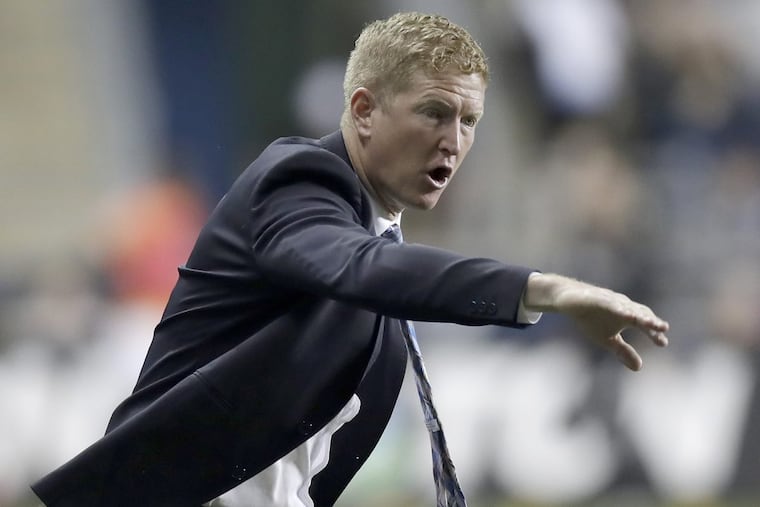Jim Curtin answers charge that Union's tactics are too rigid, and Earnie Stewart backs him up
The Union are rightly praised for teaching their youth teams the same tactics that the senior team employs. Top teams around the world think the same way. But when Jim Curtin's team gets stuck in holes on game days, that virtue can become a vice.

Union manager Jim Curtin has heard the charge from fans and media that he is too tactically inflexible for his own good.
He knows how much of a stir it caused when just once this year, in late September, the starting lineup formation was portrayed by the Union's social media team as being just a little bit different from the usual 4-2-3-1 setup. He insisted that it wasn't a big deal, and still does.
But when any soccer team bases its on-field identity on a system-based approach, it becomes news when there's any deviation. Ask English devotees of the 4-4-2, or Dutch students of Johan Cruyff's "total football" 4-3-3.
In some circumstances, a system can be a virtue. The Union are rightly praised for teaching their youth teams the same tactics that the senior team employs. Top teams around the world think the same way.
But when Curtin's team gets stuck in holes on game days, a system can quickly become a vice.
"That's certainly when it's going to get pointed to, and that's healthy," Curtin told the Inquirer and Daily News in a recent interview. "I understand the criticisms. … If we have three more wins this year, you don't get questions about it. That's natural."
Curtin would have avoided questions about many other subjects as well if his team had three more wins this year. He knows he has to bear that burden.
Fortunately for him, Union sporting director Earnie Stewart has Curtin's back in a big way.
"In good times, you can play any formation that there is," Stewart said. "The system-based approach is more about when things do not go right. That's when everybody expects change. That's something I don't believe in."
Things did not go right at the start of the season. The Union opened the year with an eight-game winless streak, and Curtin was slammed for refusing to shake things up. Stewart heard the critics, and didn't agree with them.
"Everybody was saying, 'You've got to change this and that' — no," Stewart said. "When it's not going well, you don't change everything. There's already chaos, and now you're going to add chaos to that."
Stewart also believes that a system-based tactical approach can boost a team that has a talent disadvantage relative to others.
Such as … well …
"Our players — quite frankly, they are not as good, as talented, yet — let's say that — as Toronto is," he said. "They have a very talented group, they have a lot of experience, they have players that can change the game at every single moment."
Toronto also has the highest single-season points total in MLS history, and a place in this year's Eastern Conference final after reaching last year's title game. The Union would like to reach such heights some day.
For now, Stewart said, "our players need something to fall back on."
"If you know what your teammate is doing to the left and what your teammate is doing to the right, and where he's going to be when you have the ball and you can get that ingrained into you, that will help you in a stressful game where you need to make decisions all the time," he said. "Especially defensively."
Stewart and Curtin preach that the Union are building. Many Union fans don't want to hear that. The team made the playoffs in 2016, then finished ninth this year, despite the same record and points total in both seasons.
Curtin believes better times are ahead, and that the team's tactical setup can help create improvement.
"The 4-2-3-1 is, when you break it down, one of the most flexible formations that there is," he said. "So there is some sophistication, and things that we're looking to build on in terms of how we move out of the 4-2-3-1."
Sophistication? How so?
"You want to give players responsibility and roles, and then have them execute in the 90 minutes," he said. "The semantics of it are frustrating sometimes because we're still building it."
He offered examples.
"Where now it does look like there's a second forward up with C.J. [Sapong]," Curtin said. "It does look like one of our outside backs is getting so forward that it looks like a back three at times, when we pick a side or a weakness in an opponent."
Curtin's role model is Tottenham Hotspur coach Mauricio Pochettino. The Argentine has built a high-flying attacking machine in North London.
"Look at the formation and the flexibility within the way they play," Curtin said. "A) It's exciting, you can't deny that; B) it's damn good defensively as well."
For much of Curtin's tenure, the Union have been neither exciting nor damn good defensively. It doesn't help that the team spends not just a fraction of Spurs' budget, but less than many other MLS teams.
The Union would likely play better soccer if they sign better players. Curtin has made no secret of wanting a playmaking midfielder and a new winger this winter.
If those deals are done right, they might also make Curtin look like a better coach.